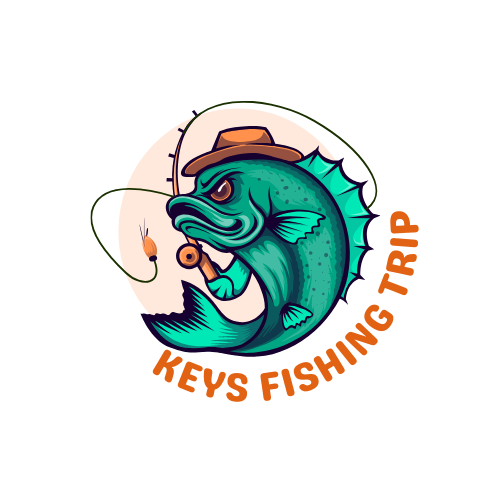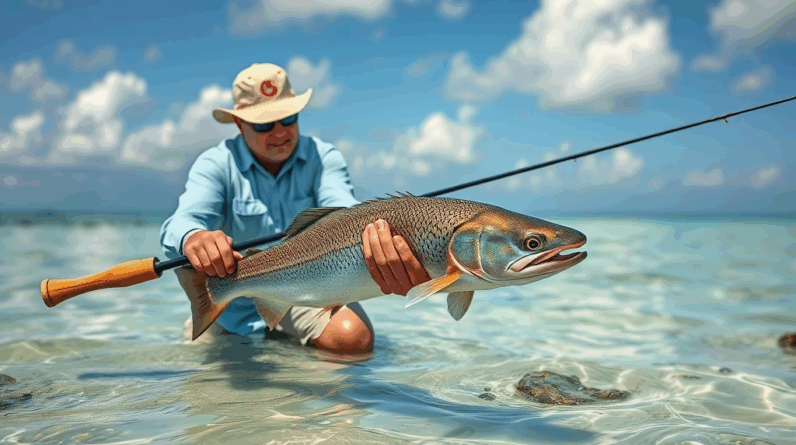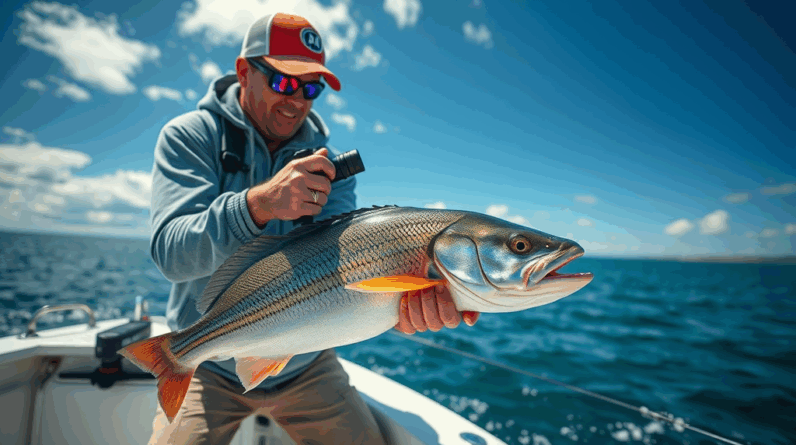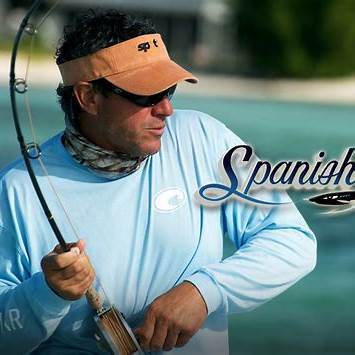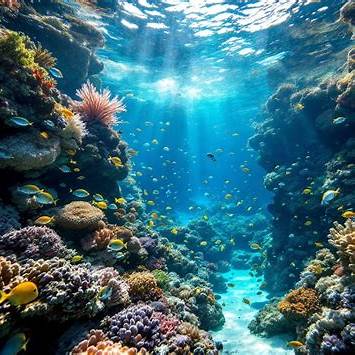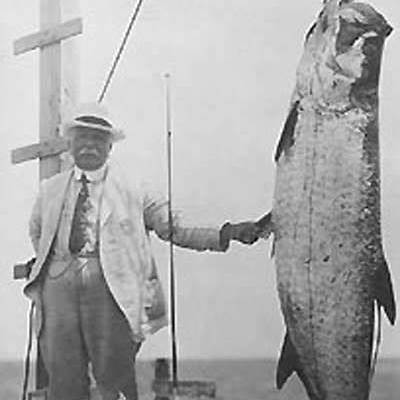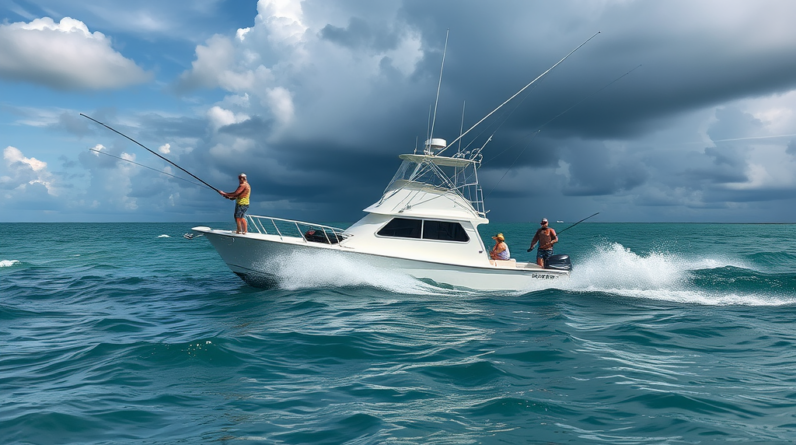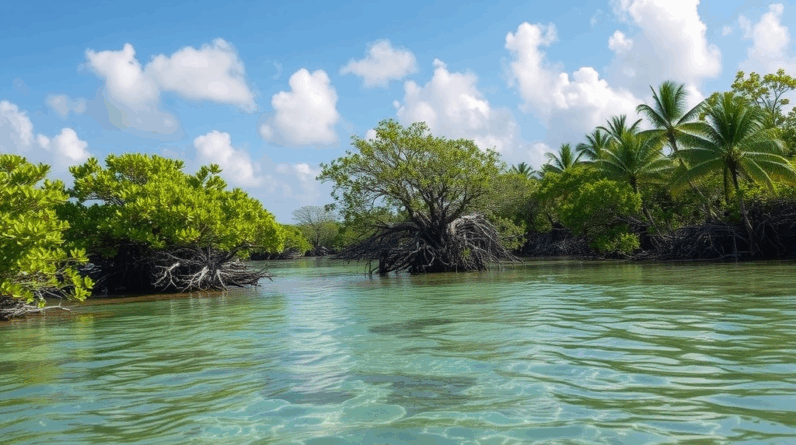
Table of Contents
The Mystique of the Mangroves: Understanding Their Vital Role in the Keys’ Fishing Experience
For anyone who loves fishing in the Keys, the mangrove ecosystems offer a mysterious and crucial element that enhances every trip out on the water. These unique coastal forests, with their tangled roots stretching into the calm, shallow waters, are much more than just scenic backdrops. They form the lifeblood of local marine habitats, playing an essential role in supporting the abundance and diversity of fish that anglers prize.
The Lifeline of Marine Habitats
Mangroves are nature’s nurseries. Their dense root systems provide shelter and protection for countless young fish and other aquatic creatures. Without this hidden refuge, many species would struggle to survive the dangers of open waters where predators lurk. The intricate labyrinth of roots helps reduce wave energy, improving water quality and creating a safe environment for juvenile fish to grow strong and healthy.
Species like snook, redfish, tarpon, and snapper thrive in these conditions. When you cast your line near a mangrove shoreline, you’re targeting areas where fish naturally gather to feed and hide. This increased fish density means a higher chance for a rewarding catch, making mangrove-lined coasts a favorite among both novice and experienced anglers.
Mangroves and Their Role in Food Chains
Mangroves don’t just provide shelter; they are also vital for feeding the local fish populations. Leaf litter and organic matter fall from the trees into the water, breaking down into nutrients that fuel a complex food web. Tiny organisms like plankton and small crustaceans feast on these nutrients, and in turn, become food for small fish and juvenile species. These smaller creatures attract larger predatory fish, creating a balanced ecosystem that sustains abundant fisheries.
Because of this natural food source, mangroves help maintain healthy fish populations year-round. As an angler, this means you are fishing in a dynamic, well-supported environment where fish are more likely to be active and plentiful.
Protecting the Mangroves Safeguards Fishing Futures
Understanding the connection between mangroves and your fishing experience means recognizing the importance of preserving these ecosystems. Unfortunately, mangroves face threats from development, pollution, and climate change. Damage to these areas can disrupt fish habitats and lead to decreased fish numbers, directly impacting fishing success.
Local conservation efforts work hard to protect and restore mangrove areas, and as someone who enjoys fishing in the Keys, supporting these initiatives helps ensure healthy fish populations for years to come. Being mindful of your impact when fishing near mangroves—such as avoiding damage to roots or leaving no trash behind—contributes to keeping these ecosystems thriving.
What Anglers Can Expect
Fishing near mangroves is often a rich and rewarding experience due to the biodiversity they support. Here are some ways mangroves enhance the fishing adventure:
- Diverse Species: You can encounter a wide variety of fish species, ranging from game fish to bottom dwellers.
- Consistent Action: With natural shelter and food, fish tend to stay active around mangroves, increasing your chances of a catch.
- Scenic and Calm Fishing Spots: The still waters among mangroves create peaceful environments perfect for casting or trolling.
- Learning Opportunities: Observing how fish interact with the mangrove ecosystem deepens your understanding of local marine life.
The Mystery Beneath the Surface
At first glance, mangroves may seem like just another coastal feature, but their complexity and ecological importance add a layer of mystique to your fishing outings. There’s a sense of connection when you fish alongside these ancient trees, feeling the pulse of life hidden beneath the water’s surface. Each root and branch plays a part in crafting an environment where fish flourish, creating memorable moments for anglers discovering the rhythms of the Keys.
Next time you plan a fishing trip in the Florida Keys, consider spending time exploring mangrove-lined shorelines. Embrace the mystery and wonder of these ecosystems—they are more than just habitat; they are the foundation of the vibrant fishing culture that defines the Keys.
How Mangrove Ecosystems Support Diverse Fish Populations in the Florida Keys
The Vital Role of Mangroves in Fish Habitats
Nestled along the coastlines of the Florida Keys, mangrove ecosystems create a unique and essential environment that supports a rich variety of fish species. These complex networks of salt-tolerant trees and shrubs form dense thickets that serve as nurseries, feeding grounds, and protective shelters for countless marine creatures. The mangroves’ intricate root systems not only stabilize the shoreline against erosion but also provide an ideal habitat where young fish can grow safely away from predators.
If you’re an angler exploring the Florida Keys, understanding how mangroves bolster fish populations can deepen your appreciation of the waters you cast your line into. Many fish species that draw enthusiasts to the Keys depend on these coastal forests for critical stages of their lifecycle. The shading canopy of mangroves helps regulate water temperatures and maintain oxygen levels, creating a more hospitable environment for diverse aquatic life.
How Mangrove Roots Create a Thriving Environment
The tangled roots of mangrove trees extend into the shallow waters, forming a three-dimensional habitat. This root maze offers refuge for juvenile fish, shrimp, and crabs, allowing them to hide from larger predators. At the same time, these roots collect organic matter and trap sediments, enriching the water with nutrients. This nutrient buildup supports tiny organisms such as plankton, which serve as the base of the aquatic food chain.
You’ll often find species like snappers, groupers, tarpon, and mangrove snapper frequenting these areas. The roots not only protect the young fish but also attract adult fish looking to feed on the abundant smaller creatures that thrive here. This dynamic ecosystem promotes a healthy and balanced fish population by ensuring food, shelter, and breeding grounds are readily available.
The Importance of Mangroves for Juvenile Fish Growth
One of the most fascinating aspects of mangrove ecosystems is their role as nurseries. When fish hatch in offshore reefs or open waters, their tiny young often migrate to the safety of mangrove-lined bays. There, the sheltered waters and plentiful food resources create perfect conditions for rapid growth. These juvenile fish have a higher chance of survival within the safety of mangrove habitats compared to open waters where predators are more prevalent.
Species such as snook, tarpon, and barracudas rely on mangrove nurseries to reach maturity. Protecting these ecosystems means preserving the future populations of fish that are vital both to the Keys’ marine biodiversity and to the recreational fishing economy.
How Mangroves Influence the Fishing Experience in the Keys
For anyone fishing in the Florida Keys, mangroves enhance the overall experience by supporting robust fish populations that make the waters lively and productive. Anglers appreciate the diversity of fish species that gather near mangrove edges, increasing the chances of a successful catch. These areas are often hotspots where multiple species can be found in close proximity, offering opportunities to target different types of fish during the same outing.
Additionally, the calm waters shielded by mangroves provide comfortable conditions for fishing, whether you prefer casting from a boat, kayak, or the shoreline. The presence of healthy mangrove forests also indicates a well-balanced marine ecosystem, usually translating to cleaner waters and abundant marine life.
Protecting Mangrove Ecosystems Benefits Everyone
The vitality of fish populations in the Florida Keys hinges on the health of its mangrove habitats. Pollution, development, and climate change pose threats to these essential ecosystems. When mangroves deteriorate, fish nursery grounds shrink, and the entire marine food chain is disrupted. This not only diminishes fish populations but also impacts the livelihoods of local fishermen and the enjoyment of visitors seeking a rewarding fishing experience.
You can contribute to the preservation of these natural treasures by supporting conservation efforts, practicing responsible fishing, and spreading awareness about the importance of mangroves. Maintaining the balance in these coastal environments ensures that future generations of anglers and marine life enthusiasts will continue to benefit from the flourishing fish populations that mangroves help sustain.
Key Benefits of Mangrove Ecosystems for Fish in the Florida Keys
- Nursery grounds: Provide safe spaces for juvenile fish to grow.
- Protection: The root structures offer shelter from predators and harsh environmental factors.
- Food source: Nutrient-rich waters support abundant plankton and small organisms consumed by fish.
- Enhanced biodiversity: Support a wide range of fish species, promoting ecological balance.
- Stable environment: Help maintain water quality, oxygen levels, and temperature regulation.
In short, the mangrove ecosystems of the Florida Keys are indispensable contributors to the vibrant and diverse fish populations that define the region. Whether you’re a seasoned angler or a casual admirer of marine life, recognizing the mystique of mangroves enriches your connection to this remarkable coastal environment.
Seasonal Changes in Mangrove Habitats and Their Impact on Local Fishing
The mangrove habitats found along coastal regions, particularly in the delicate ecosystems of the Florida Keys, are more than just scenic landscapes. These unique environments undergo noticeable seasonal transformations that play a critical role in shaping local fishing experiences. For anglers and locals who rely on fishing, understanding these seasonal shifts can greatly enhance the success and enjoyment of their fishing excursions.
The Rhythm of the Seasons in Mangroves
Mangroves thrive in tropical and subtropical areas, where seasonal changes are less extreme compared to temperate zones but are nonetheless significant. Key seasonal elements such as rainfall, temperature fluctuations, and tidal changes influence the health and behavior of mangrove ecosystems. These shifts affect water salinity and nutrient availability, which in turn impact the marine life that inhabits or visits these areas.
During the wetter months, increased rainfall dilutes the salinity of the waters around mangroves. This seasonal freshwater input refreshes the ecosystem, encouraging the growth of smaller plants and algae which serve as food sources for many species. In contrast, the drier season leads to higher salinity levels, often causing certain species to become less active or relocate to areas with more favorable conditions.
Fish Behavior and Seasonal Patterns
Fish species that depend on mangrove habitats respond noticeably to these changes. Many fish use the roots of mangroves as safe nurseries during spawning seasons, especially in the spring and early summer when water temperatures rise. Juvenile fish find shelter and abundant food here, creating hotspots for fishing in these periods.
On the other hand, during late summer and fall, the shift in water temperature and salinity can trigger migrations or changes in feeding habits. Predatory fish may be more active as they follow the movements of smaller fish and crustaceans that inhabit the mangroves. This behavior creates dynamic fishing opportunities as anglers track shifting fish populations.
How Mangrove Conditions Affect Catch Types
The variety of species available to fishermen changes seasonally in mangrove zones. For example, in the Florida Keys, species like snapper, tarpon, and snook flourish around mangrove roots during specific months. Here’s how seasonal changes often influence their availability:
- Spring: Juvenile fish begin to emerge in sheltered waters, making it an ideal time for catching young snapper and smaller game fish.
- Summer: Increased water temperatures boost feeding activity, drawing larger fish such as tarpon into shallow mangrove areas for hunting.
- Fall: Migratory patterns can bring a mix of resident and passing species near mangrove fringes, offering diverse fishing experiences.
- Winter: Cooler temperatures may reduce fish activity, but some species concentrate in deeper mangrove channels, creating targeted fishing spots.
Nutrient Cycles and Their Influence on Fish Productivity
Mangroves contribute to nutrient cycling by trapping organic matter and preventing soil erosion. Seasonal leaf drop and detritus accumulation add crucial nutrients to both water and sediment. As microorganisms break down this material, they provide a basal food source that supports diverse aquatic life.
These nutrient pulses are strongest at certain times of the year and spread through the food web, resulting in periods of higher fish productivity. Fishermen noticing an increase in baitfish presence during these times are often rewarded with better catches, as larger predator species are drawn to the area.
Adapting Fishing Strategies to Seasonal Mangrove Dynamics
To maximize fishing success around mangroves, local anglers often adjust their techniques based on seasonal behavior and environmental conditions. This might include:
- Targeting shallow roots and protected bays during spawning seasons when juvenile fish are abundant.
- Using live bait during summer months to attract active predatory species.
- Exploring deeper mangrove channels or adjacent open waters in cooler seasons when fish retreat.
- Monitoring tide schedules closely, as tidal movements strongly influence fish feeding and movement in mangrove systems.
These adjustments not only improve fishing results but also support sustainable practices, allowing the mangrove ecosystem to continue thriving. Catching fish when they are most abundant and understanding seasonal cycles help reduce stress on vulnerable populations.
Why Mangrove Conservation Matters for Fishing Futures
Preserving mangrove environments is critical for maintaining vibrant fish populations and a robust fishing industry in regions like the Keys. As these habitats face threats from development, pollution, and climate change, the seasonal cycles in mangroves may be altered, affecting fish breeding and feeding patterns.
Engaging in conservation efforts and responsible fishing ensures the mangrove ecosystems remain healthy and continue to support diverse marine life—and by extension, exceptional fishing experiences—for generations to come.
By paying attention to how seasonal changes influence mangrove habitats and using this knowledge thoughtfully, both casual fishermen and seasoned anglers can deepen their connection to these mystical ecosystems and enjoy richer, more rewarding fishing adventures throughout the year.
Conservation Efforts: Protecting Mangroves to Sustain the Keys’ Fishing Industry
Guardians of the Coastal Heritage
The mangrove forests that fringe the Florida Keys are more than just scenic backdrops; they are living strongholds critical to the preservation and vitality of the local fishing industry. These unique coastal ecosystems serve as natural buffers against storms and erosion while acting as essential nurseries for many fish species targeted by anglers throughout the Keys. Protecting mangroves is not simply about conservation for nature’s sake—it is a strategic investment in the future of the region’s economic and cultural lifeblood: its fishing communities.
Why Mangroves Matter to the Fishing Industry
The intricate root systems of mangrove trees create sheltered habitats that provide juvenile fish with protection from predators, ample food sources, and ideal breeding grounds. Species such as snapper, tarpon, and snook depend on mangroves during their early life stages before moving to open waters. Healthy mangrove ecosystems translate directly to sustainable fish populations, which means more productive fishing trips, both for recreational anglers and commercial fishers alike.
Beyond their role as nurseries, mangroves contribute to improved water quality by filtering runoff and trapping sediments. Cleaner water supports coral reefs and seagrass beds, further expanding the habitat diversity necessary for robust marine life. This ecological synergy amplifies the overall productivity of the fishing grounds, making mangrove preservation a cornerstone of maintaining consistent fish catch rates over time.
Key Initiatives in Mangrove Protection
Efforts to safeguard mangroves in the Florida Keys weave together local, state, and federal collaborations, backed by science and community engagement. Several important strategies drive these conservation successes:
- Regulatory Protection: Strict regulations limit mangrove clearing and development along sensitive coastlines, balancing growth with ecosystem health.
- Restoration Projects: Active replanting and rehabilitation of degraded mangrove areas help recover habitats lost to past activities or natural events.
- Water Quality Management: Programs aimed at reducing nutrient pollution and minimizing runoff protect mangroves from harmful algal blooms and stresses.
- Public Education and Outreach: Engaging fishermen, residents, and tourists fosters awareness of mangroves’ ecological role and encourages responsible behavior.
Community Role in Sustaining Mangroves
You, as someone who enjoys or depends on the Keys’ fishing experience, have a vital role in supporting mangrove conservation. Simple actions like avoiding propeller damage by steering clear of shallow mangrove roots, properly disposing of trash, and supporting local conservation organizations can have a meaningful impact. Getting involved in citizen science programs or volunteer mangrove planting events strengthens the community’s connection to these ecosystems and bolsters conservation momentum.
Economic Benefits of Mangrove Conservation
By protecting mangroves, the Keys safeguard millions of dollars in economic benefits tied to commercial fishing, recreational angling, and tourism driven by healthy marine environments. Studies estimate that for every dollar invested in mangrove protection, many more are returned through enhanced fishery yields and coastal resilience. This ensures that future generations of anglers can continue to enjoy the rich bounty these waters provide.
Challenges and the Way Forward
Despite their importance, mangroves face threats from coastal development, climate change, and pollution. Rising sea levels and warming temperatures may alter mangrove distribution and health. Addressing these challenges requires adaptive management practices and long-term monitoring to anticipate changes and adjust conservation efforts accordingly.
Innovative partnerships between scientists, policymakers, fishermen, and conservation groups are key to strengthening mangrove protection frameworks. Continued investment in research, habitat restoration, and sustainable fishing practices will help secure the symbiotic relationship between mangroves and the fishing culture of the Keys.
Embracing a Sustainable Future
Protecting mangroves is not merely about preserving trees; it’s about sustaining an entire way of life that revolves around the rich coastal waters of the Florida Keys. These forests form the foundation of healthy fisheries, supporting livelihoods and recreational opportunities alike. By understanding their value and committing to their conservation, you play a part in ensuring that fishing in the Keys remains a vibrant, thriving tradition well into the future.
Practical Tips for Anglers: Navigating Mangrove Areas for a Better Fishing Adventure
Understanding Mangrove Ecosystems and Their Importance for Anglers
When you think about the best spots for fishing in the Keys, mangrove areas immediately come to mind. These unique ecosystems play a vital role in enhancing your fishing adventures. Mangroves are not just picturesque coastal forests; they serve as nurseries for many fish species and provide shelter and food that attract a diverse range of aquatic life. Knowing how to navigate these environments effectively can make a big difference in your catch and overall experience.
Choosing the Right Gear for Mangrove Fishing
Because mangroves have dense roots and shallow waters, selecting the proper gear is crucial to avoid snags and lost tackle. Here are some gear tips to consider:
- Rod and Reel: Use a medium-action rod with a sturdy reel that allows you good control and enough strength for fish hiding in tight spots.
- Line and Leader: Braided lines with a fluorocarbon leader work best since they offer abrasion resistance against sharp roots and are less visible underwater.
- Lures: Soft plastics, jigs, and topwater plugs imitate the natural prey found near mangroves. Opt for weedless hooks to reduce snags.
- Landing Nets: A long-handled, rubberized landing net helps safely bring fish out of mangrove thickets without injuring them or losing your catch.
Techniques to Maximize Your Catch in Mangrove Areas
Fishing near mangroves requires a blend of patience and strategy. Here are some tips to improve your technique:
- Cast Along the Mangrove Edges: Many fish like snook, tarpon, and redfish hide along the shaded edge created by the roots. Casting parallel to the shoreline can help you target these spots.
- Work the Water’s Surface: Early mornings and late afternoons are perfect for topwater fishing. Small fish feed near the surface, and hungry predators lurk nearby.
- Watch for Feeding Activity: Look for signs like fish jumping, birds diving, or ripples on the surface. These clues can guide you toward active feeding zones.
- Use Slow and Subtle Movements: Mangrove fish can be easily spooked. Retrieve your lure with a slow, steady motion, adding small twitches to mimic injured prey.
Safety and Environmental Consciousness While Fishing in Mangroves
Navigating mangrove areas requires care not just for your safety but to preserve these vital habitats. Keep these points in mind:
- Be Mindful of Tides: Mangrove fishing spots can become challenging or inaccessible during low tide. Check tide charts before heading out to avoid being stranded or damaging fragile roots.
- Protect Yourself from Sun and Insects: Wear sun-protective clothing and insect repellent to stay comfortable as mangrove environments can be sunny and buggy.
- Practice Catch and Release: Many mangrove fish species benefit from conservation efforts. Handle fish carefully with wet hands and release them promptly to ensure sustainability.
- Avoid Anchoring on Roots: Use mud or sand flats when anchoring to prevent damaging mangrove root systems.
Navigation Tips for Finding Prime Mangrove Fishing Spots
Knowing how to find and access the best locations in mangrove zones will enhance your fishing success:
- Use GPS and Fishing Apps: Digital tools provide coordinates of productive spots and help track your favorite areas over time.
- Observe Natural Pathways: Look for channels, creeks, and water breaks within the mangrove forests where fish like to travel.
- Ask Local Experts: Connect with local guides and fellow anglers who know the mangroves well—they can share insider tips and hidden gems.
Enhancing the Fishing Experience with Patience and Respect
Spending time in mangrove habitats offers more than just fish; it connects you to a special part of coastal nature. Approach your fishing journey with patience, respect for the environment, and a willingness to learn from each outing. As you become familiar with the rhythms of mangrove waters, you’ll find your catches increase and your appreciation for these ecosystems deepens.
Ultimately, navigating mangrove areas skillfully enriches your fishing adventure in the Keys. By combining the right gear, smart techniques, safety precautions, and environmental awareness, you set yourself up for rewarding experiences and memorable days on the water.
Conclusion
The mangroves of the Florida Keys hold a special place in the fishing experience, offering more than just scenic beauty—they are living, breathing ecosystems that support a rich diversity of fish populations. These unique coastal forests create essential nursery grounds, sheltering juvenile fish and providing plentiful feeding opportunities. As seasons change, so do the conditions within these mangrove habitats, influencing fish behavior and presenting anglers with varying challenges and rewards throughout the year.
Protecting the mangroves is critical not only for preserving this delicate balance but also for sustaining the vibrant fishing industry that depends on them. Conservation efforts aimed at safeguarding these ecosystems help maintain the health of fish populations, ensuring that both nature and anglers can enjoy the Keys’ waters for generations to come. For those eager to enhance their fishing adventures, understanding how to navigate mangrove areas thoughtfully and respectfully can lead to more successful outings and a deeper connection to the environment.
By appreciating the mystique of the mangroves and recognizing their crucial role, you embrace a fishing experience that combines skill, knowledge, and respect for nature’s intricate design. The mangroves are much more than just a backdrop—they are the heart of the Keys’ thriving aquatic life and an indispensable partner in every memorable catch.
